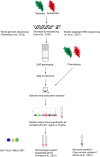Current Status and Challenges in Identifying Disease Resistance Genes in Brassica napus
- PMID: 29163558
- PMCID: PMC5681527
- DOI: 10.3389/fpls.2017.01788
Current Status and Challenges in Identifying Disease Resistance Genes in Brassica napus
Abstract
Brassica napus is an economically important crop across different continents including temperate and subtropical regions in Europe, Canada, South Asia, China and Australia. Its widespread cultivation also brings setbacks as it plays host to fungal, oomycete and chytrid pathogens that can lead to serious yield loss. For sustainable crop production, identification of resistance (R) genes in B. napus has become of critical importance. In this review, we discuss four key pathogens affecting Brassica crops: Clubroot (Plasmodiophora brassicae), Blackleg (Leptosphaeria maculans and L. biglobosa), Sclerotinia Stem Rot (Sclerotinia sclerotiorum), and Downy Mildew (Hyaloperonospora parasitica). We first review current studies covering prevalence of these pathogens on Brassica crops and highlight the R genes and QTL that have been identified from Brassica species against these pathogens. Insights into the relationships between the pathogen and its Brassica host, the unique host resistance mechanisms and how these affect resistance outcomes is also presented. We discuss challenges in identification and deployment of R genes in B. napus in relation to highly specific genetic interactions between host subpopulations and pathogen pathotypes and emphasize the need for common or shared techniques and research materials or tighter collaboration between researchers to reconcile the inconsistencies in the research outcomes. Using current genomics tools, we provide examples of how characterization and cloning of R genes in B. napus can be carried out more effectively. Lastly, we put forward strategies to breed resistant cultivars through introgressions supported by genomic approaches and suggest prospects that can be implemented in the future for a better, pathogen-resistant B. napus.
Keywords: Brassica napus; R gene; genomics; host-pathogen interaction; pathotype; qualitative resistance.
Figures


References
-
- Alamery S., Tirnaz S., Bayer P., Tollenaere R., Chaloub B., Edwards D., et al. (in press). Genome-wide identification comparative analysis of NBS-LRR resistance genes in Brassica napus. Crop Pasture Sci. 10.1071/CP17214 - DOI
-
- Ansan- Melayah D., Balesdent M.-H., Buée M., Rouxel T. (1995). Genetic characterization of AvrLm1, the first avirulence gene of Leptosphaeria maculans. Phytopathology 85, 1525–1529. 10.1094/Phyto-85-1525 - DOI
-
- Ansan-Melayah D., Balesdent M.-H., Delourme R., Pilet M. L., Tanguy X., Renard M., et al. (1998). Genes for race-specific resistance against blackleg disease in Brassica napus L. Plant Breed. 117, 373–378. 10.1111/j.1439-0523.1998.tb01956.x - DOI
-
- Australian Bureau of Statistics (2016). 7503.0 - Value of Principal Agricultural Commodities Produced, Australia, Preliminary, 2014-15 [Online]. Canberra, ACT: Available online at: http://www.abs.gov.au/ausstats/abs@.nsf/mf/7503.0 (Accessed May 1, 2017).
Publication types
LinkOut - more resources
Full Text Sources
Other Literature Sources

